Your smartwatch can automatically detect life-threatening emergencies like falls, cardiac arrest, and dangerous heart rhythms, then contact emergency services within 20 seconds even if you’re unconscious. Advanced AI sensors distinguish real emergencies from normal activities with 93% accuracy, while GPS tracking provides your exact location to responders. Features like ECG monitoring detect atrial fibrillation with 96% sensitivity, and blood oxygen sensors alert you to respiratory crises. Discover how these technologies work together to provide extensive protection.
Advanced Motion Sensors Detect Critical Emergency Situations
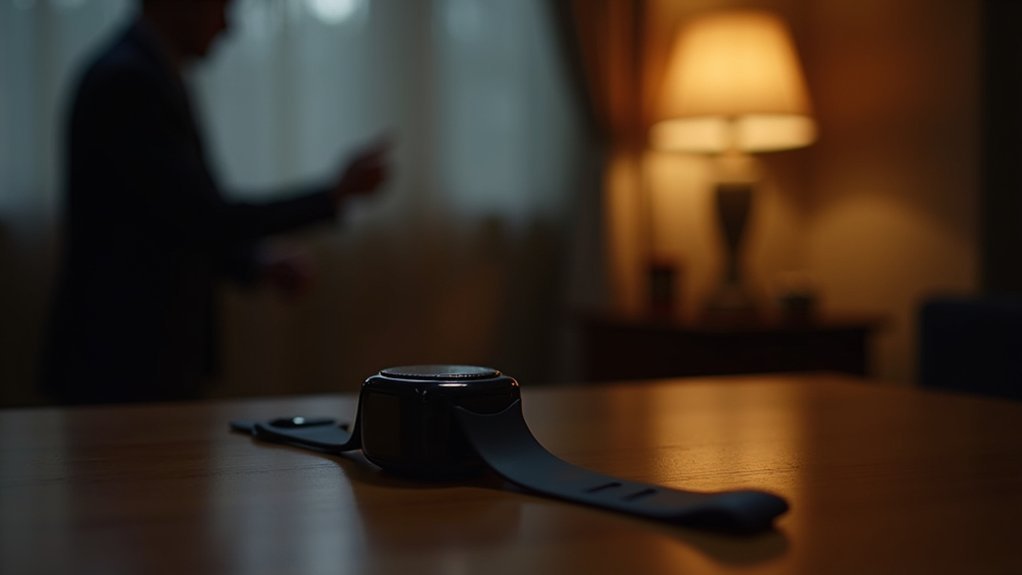
When emergencies strike, advanced motion sensors in your smartwatch can mean the difference between life and death. These sophisticated devices use AI-enhanced algorithms to detect critical situations like severe falls, car crashes, and even loss of pulse.
Google’s Pixel Watch 3 exemplifies this technology by automatically alerting emergency services when it detects no pulse using motion sensors and artificial intelligence.
Your smartwatch distinguishes between normal daily movements and genuine emergencies, reducing false alarms while maintaining accuracy. When severe impacts occur, the device immediately initiates emergency protocols, contacting responders and potentially saving precious minutes.
You can customize sensitivity levels to match your lifestyle, ensuring reliable detection without unnecessary alerts. This seamless integration with emergency services provides rapid response capabilities that could save your life. The technology relies on three-axis and six-axis gyroscopes combined with high-precision accelerometers to accurately identify different types of movement patterns and potential emergency situations.
GPS Tracking Enables Rapid Emergency Service Response
Advanced motion sensors excel at detecting emergencies, but GPS tracking transforms how quickly help reaches you. When your smartwatch detects a crisis, GPS immediately pinpoints your exact location, eliminating precious time emergency responders would spend searching. This real-time positioning enables dispatchers to send the nearest available units directly to you, greatly reducing response times that can mean the difference between life and death.
GPS tracking also allows emergency teams to monitor your movement continuously during the incident, enabling them to adjust their approach if your situation changes. The technology creates a shared operational picture among multiple response units, improving coordination and preventing duplicate efforts.
Whether you’re experiencing a medical emergency at home or trapped during a natural disaster, GPS guarantees help finds you faster and more efficiently than ever before. With over 150 million smartwatches shipped globally, this life-saving technology is becoming increasingly accessible to people worldwide.
SOS Button Technology for Instant Help Access
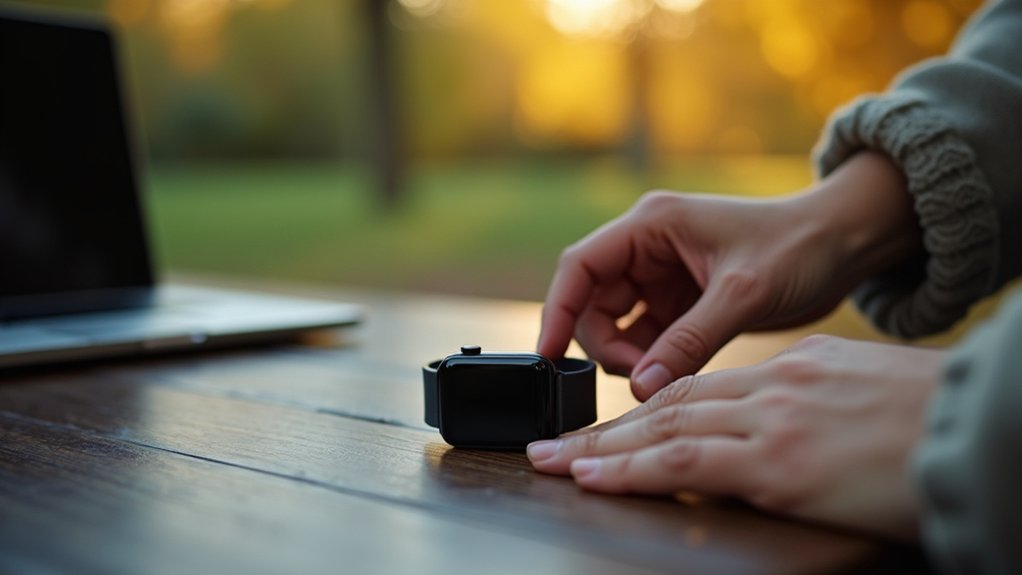
While GPS tracking excels at pinpointing your location during emergencies, SOS button technology guarantees you can instantly summon help when every second counts.
Your smartwatch’s bright red SOS button eliminates the need to fumble with screens or apps during crisis moments. Simply press and hold for a few seconds, and you’ll establish two-way communication with emergency operators who can assess your situation and dispatch help accordingly.
Here’s what makes SOS button technology so effective:
- No smartphone dependency – Your watch operates independently, ensuring help arrives even when your phone’s dead or lost.
- Automatic contact alerts – Designated emergency contacts receive instant notifications about your situation.
- Stress-proof design – The intuitive button works flawlessly even when you’re panicked or disoriented.
This streamlined approach prioritizes immediate assistance over complicated features. Emergency response services like RapidSOS process 170 million emergencies annually, demonstrating the massive scale and reliability of modern emergency response systems that your smartwatch can instantly connect you to.
Heart Rate Monitoring Identifies Life-Threatening Events
Your smartwatch continuously monitors your heart rate through photoplethysmography (PPG) technology, instantly detecting dangerous changes that could signal life-threatening events like cardiac arrest or ventricular tachycardia.
When the device identifies irregular patterns or arrhythmias such as atrial fibrillation, it triggers automatic alerts with both visual and audible warnings to notify you and nearby bystanders.
These advanced cardiac emergency response systems can immediately contact emergency services, provide your location data, and even guide witnesses through CPR instructions while you’re experiencing a medical crisis. Clinical studies demonstrate that PPG technology shows a high correlation with traditional ECG readings when detecting life-threatening arrhythmias, validating the accuracy of wrist-worn monitoring devices.
Detecting Sudden Heart Rate Changes
Because your heart rate serves as a vital indicator of your cardiovascular health, smartwatches continuously track this data to establish your personal baseline and detect potentially dangerous deviations.
When your device notices sudden changes, it can alert you to serious health concerns requiring immediate attention.
Your smartwatch monitors several essential patterns:
- Sudden spikes above normal ranges – Swift increases may signal cardiac emergencies or extreme stress, prompting alerts for immediate medical evaluation.
- Unexpected drops below 60 bpm – Low heart rates outside exercise recovery periods can indicate serious underlying conditions.
- Irregular rhythm patterns – Deviations from your established baseline help identify potential arrhythmias or other cardiac issues.
These real-time alerts enable you to seek prompt medical intervention when abnormal patterns emerge. When critical heart rate anomalies are detected, your smartwatch can automatically contact predefined emergency contacts to ensure rapid response even if you’re unable to call for help yourself.
Arrhythmia Recognition and Alerts
Among the most serious cardiac irregularities your smartwatch can detect, arrhythmias represent potentially life-threatening conditions that require immediate medical attention. Your device uses single-lead ECG technology combined with photoplethysmography to monitor heart rhythm continuously, analyzing pulse irregularities through machine learning algorithms.
| Detection Capability | Accuracy Rate |
|---|---|
| Atrial Fibrillation Sensitivity | Up to 96% |
| Atrial Fibrillation Specificity | Up to 94% |
| Normal Sinus Rhythm | Nearly 100% |
| Diagnostic Performance (AUC) | 0.99 |
| Confirmed AF After Alert | 34% of cases |
When your smartwatch detects irregular rhythms, it enables rapid medical evaluation and potential anticoagulation therapy initiation. Early identification reduces stroke risk considerably, as many arrhythmias remain asymptomatic until complications develop. However, you’ll need traditional ECG confirmation before clinical decisions, since inconclusive readings can occur in up to 31% of cases. These consumer-grade devices are widely available without prescription requirements, making advanced cardiac monitoring accessible to the general population.
Cardiac Emergency Response Systems
When cardiac arrest strikes, smartwatches equipped with advanced photoplethysmography sensors and motion detection can automatically identify pulselessness and contact emergency services without human intervention.
Google’s FDA-cleared technology achieves 99.99% specificity while reducing unwitnessed cardiac arrest cases that traditionally challenge emergency response teams.
Your smartwatch transforms into a life-saving device through:
- Real-time pulse monitoring – PPG sensors continuously track your heart rhythm and detect when pulselessness occurs
- Automatic emergency alerts – The system contacts 911 immediately without requiring your conscious action
- Rapid response coordination – Emergency services receive instant notifications, greatly improving survival rates through timely intervention
This technology generates approximately one false alarm per 21.67 user-years, making it reliable enough for everyday use while potentially saving your life during critical moments.
Over 90% of users expressed genuine interest in automated cardiac arrest detection technology, demonstrating strong public acceptance for these potentially life-saving innovations.
Blood Oxygen Sensors Alert to Respiratory Emergencies
As smartwatch technology advances, blood oxygen sensors have emerged as critical tools for detecting respiratory emergencies before they become life-threatening.
When your blood oxygen saturation (SpO2) drops below 90%, you’re experiencing hypoxemia—a condition requiring immediate medical attention.
Samsung smartwatches have demonstrated high sensitivity in detecting these dangerous drops, while Apple Watch Series 7 shows strong accuracy compared to clinical devices.
These sensors can alert you to seek help quickly, potentially preventing severe outcomes.
You’ll become more aware of your respiratory health and may adjust your activities based on real-time feedback.
However, accuracy varies between devices—Garmin Venu 2s tends to underestimate SpO2 levels, and environmental factors like direct sunlight can affect readings. Studies show that some devices experience high data missingness rates, with certain models failing to provide readings nearly one-third of the time.
Despite limitations, these alerts encourage proactive health monitoring.
Fall Detection Systems With Automatic Emergency Notifications
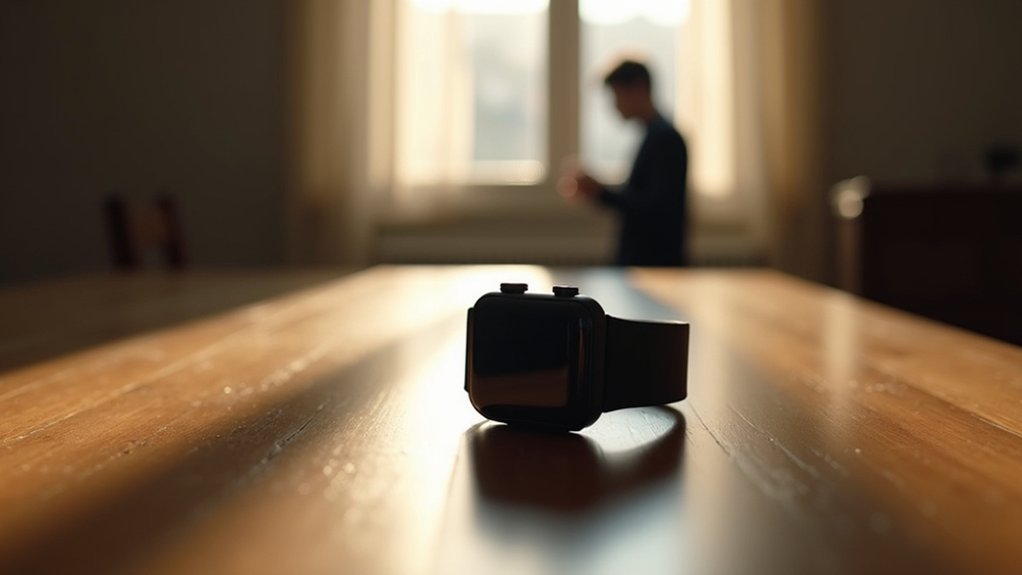
Your smartwatch’s fall detection system uses sophisticated motion pattern detection technology that analyzes your movement data to identify when you’ve taken a tumble.
When the device recognizes a fall pattern, it automatically triggers an alert response system that gives you seconds to cancel before sending notifications.
If you don’t respond, the system immediately contacts your designated emergency contacts with your location and fall alert information. Current studies show these systems achieve 93% accuracy in detecting actual falls, making them highly reliable for real-world emergency situations.
Motion Pattern Detection Technology
Fall detection technology transforms your smartwatch into a vigilant guardian that monitors every movement through sophisticated accelerometers and gyroscopes.
These sensors continuously collect motion data, analyzing patterns to distinguish between your routine activities and potential falls.
Your device’s algorithms achieve impressive accuracy rates:
- Detection sensitivity ranges from 77% to 95% depending on fall type and wrist position
- Specificity exceeds 99% with false-positive rates as low as 1.7%
- Overall accuracy reaches 89-93% in controlled studies
However, you’ll find positioning matters considerably.
Falls on your watch-wearing side show higher sensitivity (95%) compared to opposite-side falls (80-84%). For individuals with Parkinson’s disease, postural instability creates additional fall risks that require more specialized detection capabilities.
While false negatives remain at 11-16%, your smartwatch’s real-time monitoring capabilities make it an increasingly reliable safety companion for vulnerable populations.
Automatic Alert Response System
When your smartwatch detects a fall, it immediately springs into action with a sophisticated alert response system that vibrates and displays an on-screen prompt asking if you need assistance. You’ve got 60 seconds to respond before the system escalates. If you can’t answer, your watch automatically sends your location to emergency contacts and may even call emergency services directly.
| Response Time | Action |
|---|---|
| 0-60 seconds | User verification prompt |
| After 60 seconds | Auto-contact emergency contacts |
| No user response | Location sharing activated |
| Hard falls | Potential direct emergency call |
This automated approach guarantees you’ll receive help even when incapacitated. Cellular-enabled models work independently, while others need smartphone connectivity. The system’s high specificity prevents false alarms while maintaining reliable emergency response capabilities. For optimal functionality, your smartwatch must stay within approximately 30 feet of your paired phone when using Bluetooth connectivity.
Emergency Contact Notifications
Once your smartwatch’s fall detection system determines you need help, it immediately activates emergency contact notifications that can mean the difference between timely rescue and prolonged danger.
Your smartwatch follows a structured alert process to guarantee help reaches you quickly:
- Immediate Alert Display – Your watch vibrates and shows an on-screen prompt asking if you need assistance, giving you control over the situation.
- Automatic Escalation – If you don’t respond within the timeout period, your smartwatch automatically sends alerts to your pre-configured emergency contacts.
- Location Sharing – Your current GPS coordinates are transmitted with the alert, helping responders find you even if you’re unconscious or unable to communicate.
Some advanced smartwatches can even contact emergency services directly, bypassing the need for emergency contacts to make that critical call themselves. The sophisticated algorithms that power these devices analyze your movement data in real-time to distinguish between genuine emergencies and everyday activities.
Customizable Alert Settings for Individual Health Conditions
Because every person’s health profile is unique, modern smartwatches allow you to tailor emergency alert settings to match your specific medical conditions and lifestyle needs.
You can customize heart rate thresholds to detect irregular rhythms or cardiovascular issues that matter most to your health. Fall detection sensitivity adjusts to your environment, whether you’re at home or exercising outdoors.
If you have diabetes or asthma, you’ll set condition-specific alerts that trigger appropriate responses. Your emergency contact lists can include different people for various situations – family for falls, doctors for heart issues.
Activity tracking alerts notify you about periods of inactivity or unusual patterns. Location-sharing settings balance privacy with safety, ensuring help reaches you quickly when needed. Professional response specialists are available around the clock to assess your emergency and coordinate the most appropriate help for your situation.
Emergency Contact Networks Save Precious Response Time
While customized alert settings form the foundation of smartwatch safety features, your device’s ability to instantly connect with emergency contact networks determines how quickly help actually reaches you during a crisis.
Your smartwatch can automatically dial emergency services within 20 seconds if you’re unresponsive, dramatically reducing response initiation time.
Emergency contact networks excel through three key advantages:
- Automatic detection – Your device alerts responders even when you’re unconscious or unable to physically call for help.
- Real-time data sharing – Continuous location, heart rate, and movement data help responders assess your situation before arriving.
- Simultaneous coordination – Multiple contacts and first responders receive instant updates, ensuring broad awareness and coordinated response efforts.
This networked approach transforms your wrist into a lifeline that works when you can’t. Beyond immediate emergencies, smartwatches can also detect infectious diseases in presymptomatic individuals, preventing potential health crises before they escalate.
Smartwatch Alerts Vs Traditional Medical Alert Systems
Your smartwatch’s emergency capabilities represent just one option in a broader landscape of personal safety devices.
Traditional medical alert systems like Life Alert prioritize simplicity with one-button activation and 24/7 monitoring by certified operators. They offer superior battery life lasting several days and operate independently through cellular networks without requiring smartphone pairing.
Traditional medical alert systems deliver reliable emergency response through simple one-button activation and days-long battery life without smartphone dependency.
Smartwatches provide emergency features alongside fitness tracking but often need daily charging and internet connectivity. While both systems include GPS tracking and fall detection, dedicated medical alert devices typically deliver more reliable performance during emergencies.
Smartwatches excel in convenience and additional health monitoring, but traditional systems focus exclusively on emergency response with professional operators and backup features ensuring consistent availability when you need help most. True medical alert smartwatches feature built-in cellular connectivity and don’t require a paired smartphone for emergency communication.
Real-World Success Stories of Life-Saving Emergency Alerts
You’ve likely heard claims about smartwatches saving lives, but real stories prove these devices aren’t just marketing hype.
From detecting heart attacks before symptoms become severe to automatically calling for help when someone can’t reach their phone after a fall, these wearables have documented track records of emergency interventions. Advanced devices like Bay Alarm Medical’s SOS Smartwatch use cloud-based machine learning to verify genuine emergencies and reduce false alarms.
Let’s examine specific cases where smartwatch alerts made the difference between life and death during medical crises.
Heart Attack Detection Success
The Apple Watch’s ECG feature has already saved countless lives by detecting irregular heart rhythms that users didn’t even know they had. When your smartwatch detects atrial fibrillation or other dangerous irregularities, it immediately alerts you to seek medical attention.
This early warning system has proven vital in preventing full-blown heart attacks.
Real heart attack detection successes include:
- Emergency Room Visits: Users receiving atrial fibrillation alerts sought immediate medical care, discovering blockages before heart attacks occurred.
- Pulmonary Embolism Catches: Smartwatches detected dangerous blood clots heading toward the heart, prompting life-saving emergency treatment.
- Silent Heart Attack Prevention: Continuous monitoring caught irregular rhythms signaling impending cardiac events in otherwise healthy individuals.
You’re fundamentally wearing a 24/7 cardiac monitor that could save your life. In documented cases, smartwatches have detected supraventricular tachycardia with heart rates exceeding 180 beats per minute, alerting users to seek immediate emergency care before their condition became life-threatening.
Fall Recovery Stories
Beyond cardiac emergencies, smartwatches have transformed into personal safety guardians that detect when you’ve taken a dangerous fall.
Real users share compelling stories of how this technology saved their lives when accidents struck unexpectedly. One cyclist’s Apple Watch detected his crash and automatically contacted emergency services when he couldn’t respond. First responders found him unconscious on a remote trail, potentially preventing a fatal outcome.
Another case involved an elderly woman who slipped at home—her smartwatch alerted family members who discovered her with a broken hip, unable to reach her phone. Toralv Stvang experienced a sudden fall in his bathroom due to a blood pressure drop, and his Apple Watch Series 4’s fall detection feature triggered an emergency notification that led police to contact his wife with his location.
These devices have prompted life-saving interventions across various scenarios: outdoor hiking accidents, bathroom falls, and cycling incidents. When you’re unconscious or immobilized, your smartwatch becomes your voice, sending GPS coordinates and emergency alerts to designated contacts.
Medical Emergency Responses
When medical emergencies strike without warning, smartwatches have proven their worth as silent sentinels that can mean the difference between life and death.
These devices continuously monitor your essential signs and automatically alert emergency services when they detect life-threatening situations.
Real-world rescues demonstrate their effectiveness:
- Heart Rate Detection – An Apple Watch detected a dangerously low heart rate and automatically called emergency services, resulting in timely hospital admission and life-saving treatment.
- Blood Oxygen Monitoring – A smartwatch sensing dangerous oxygen drops during altitude sickness alerted the wearer to seek immediate help, preventing serious health decline.
- Cardiac Rhythm Analysis – ECG functionalities detecting irregular heart rhythms initiated emergency calls to 911, providing paramedics with crucial information before arrival.
Fall detection technology has saved stroke victims who lost consciousness while alone, with the watch automatically alerting family members who then called 911, enabling doctors to administer clot-busting medication within the critical treatment window.
Frequently Asked Questions
How Accurate Are Smartwatch Emergency Alerts in Avoiding False Alarms?
You’ll experience excellent accuracy with smartwatch emergency alerts avoiding false alarms. They achieve 98-100% specificity rates and only 1.7% false-positive rates, ensuring you won’t face unnecessary emergency responses or stress.
What Happens if My Smartwatch Battery Dies During an Emergency?
If your smartwatch battery dies during an emergency, you’ll lose critical fall detection and SOS features. You won’t be able to send alerts or contact emergency services, potentially jeopardizing timely assistance.
Can Smartwatch Emergency Alerts Work Without Cellular or Wifi Connectivity?
You can’t send emergency alerts without cellular or WiFi connectivity since smartwatches need internet access to transmit messages. However, some medical alert watches operate independently through dedicated emergency networks.
How Much Do Smartwatch Emergency Alert Services Typically Cost Monthly?
You’ll typically pay between $15 to $48 monthly for smartwatch emergency alert services. Apple Watch monitoring costs around $14.99/month, while Bay Alarm Medical starts at $34.95/month plus additional fall detection fees.
What Age Groups Benefit Most From Smartwatch Emergency Alert Features?
You’ll find older adults benefit most from smartwatch emergency alerts due to fall risks and health monitoring needs, while younger adults gain advantages during outdoor activities and solo adventures.

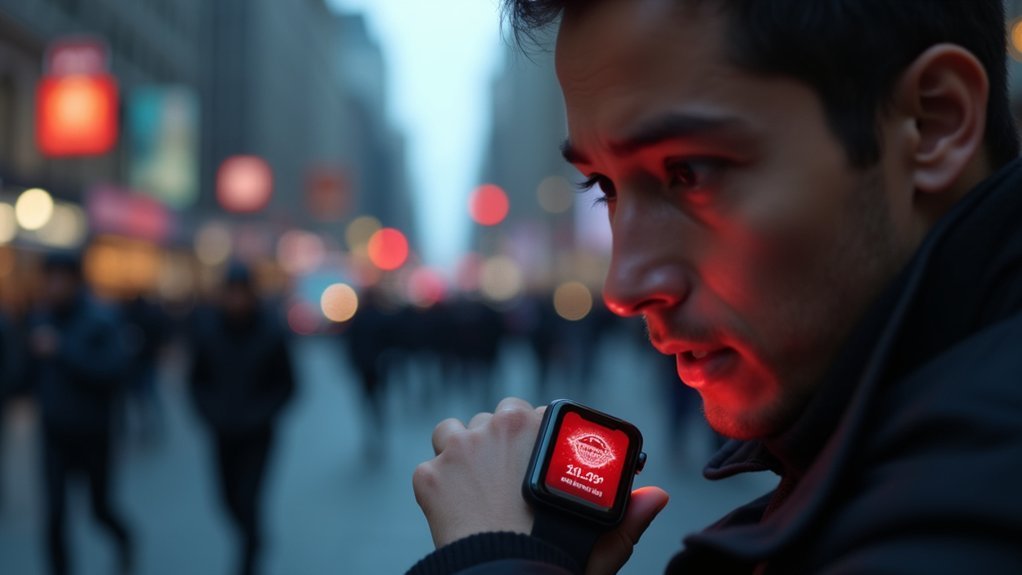


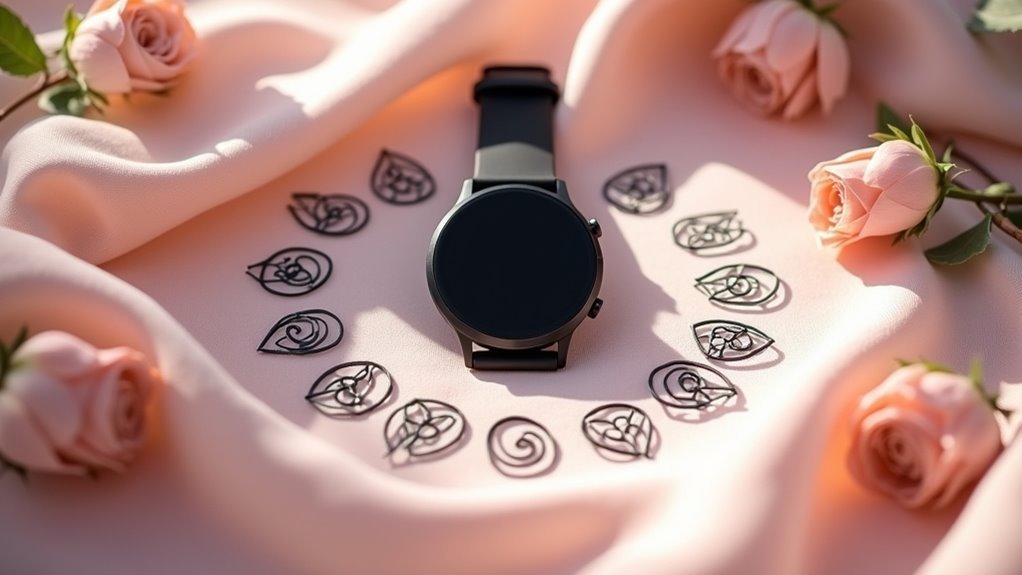
Leave a Reply